Asi před týdnem jsem kontaktoval pana RNDr. Pavela Spurného, CSc, jste jeho spolupracovnice? V případě dopadu uváděných těles jsem ochoten být nápomocen v západních Čechách možné ho dohledání tělesa zcela dobrovolně bez nároku na odměnu.
METEORITY
Categories: What didn't fit elsewhere
Part 1
Ameteorite is a body that has fallen to the Earth's surface due to favourable conditions. It passes through our atmosphere at speeds ranging from 11 to 72 km/s. Most meteorites melt and evaporate in the process. Only those with the right density, velocity and structure to begin with will pass through. Iron meteorites, for example, are less likely to melt as they pass, increasing their probability of impact. The more fragile meteorites must have a high initial mass. The last important factor is the height from which they come. If they fly more than 30 km above the ground, there is a high probability that they will evaporate.
Where do meteorites come from?
Meteorites usually represent the remnants of the formation of the solar system more than four and a half billion years ago. But many of them were formed later, by collisions of asteroids in the region between Mars and Jupiter, as well as by the passage of large hairpins.
The most common "shooting stars" occur in August, November and April. Scientists estimate that about 4,000 tonnes of meteoric material fall to Earth each year.
How can we classify them?
Meteorites that reach us fall into two basic types. Condrites and siderites. Then, according to their composition, iron, ironstone and, which are the most abundant.
Achondrite is a type of rocky meteorite formed by the accumulation of dust in the parent nebula. It's composed primarily of silicates. The cross-section shows spherical granules, which are very reactive and erode rapidly under terrestrial conditions.
Chondrites are the oldest known materials in the solar system. Almost all are more than 4.56 billion years old, roughly equivalent to the age of the solar system. Roughly 86% of known meteorites are chondrites. The largest chondrite was found in 1969 near the Mexican city of Allende. All of its fragments weigh two tons.
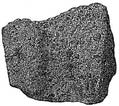
Siderite is composed primarily of iron and nickel. It probably comes from the cores of shattered asteroids. The only thing they have in common with siderite is that they contain iron. The largest siderite found weighs 60 tons and is in Namibia. Judging by the degree of corrosion, it's estimated to have originally weighed about 100 tonnes.
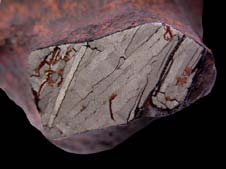
types of meteorites:
| Metallic | Primarily iron and nickel |
| silicon/metal | a mixture of iron and silicate materials |
| chondrites | by far the largest number of meteorites found; similar in composition to the mantle and crust of terrestrial-type planets |
| carbonaceous chondrites | very similar in composition to the Sun without volatiles |
| achondrites | similar to terrestrial basalt; meteorites thought to have originated on the Moon or Mars |
Meteorite deposits
We find them all over the world. The best meteorites are iron meteorites, which are very atypical of their surroundings and therefore easy to spot. They are also not very dependent on their surroundings. Chondrites are not very resilient after impact and usually disintegrate when it rains. In addition, they often resemble the surrounding rock, which makes them difficult to locate.
The largest concentrations of meteorite deposits have recently been recorded in Antarctica. As the ice thaws, they gradually rise to the surface. Here they are easily recognisable because of their typically dark colour. Small teams of explorers on snowmobiles have collected thousands of them.
In the Hoher Straussberg and Hirschfaeng mountain ranges they are found at altitudes between 1,300 and 1,900 metres. However, several tens of percent of the mountain ridges are completely impassable or only very difficult to climb. Another part consists of mountain meadows in valleys where the terrain is so rugged that systematic walking is often impossible. There is therefore a good chance that meteorites are still found even in places that are so-called "searched". The rest of the area consists of woodland on slopes of varying steepness and slash and burn. Unfortunately, the meteorite cannot be expected to cause any visible damage on impact, so searching in the forest cover is not easy and it is easy to miss the meteorite.
Since at least 20 kg of material is known for sure to be in the area and only less than 10 percent of this amount has been discovered so far, the area can be considered an open hunting ground.
Another prominent site is the deserts, where modern all-terrain vehicles are being used to search for it. Already at a distance, the dark stones are clearly visible.
Tips on the sites
On January 3, 1970, several cameras managed to capture the path of a meteor with a total weight of 17 kg. The largest had a mass of ten kilograms. The meteorite was named Lost City after the town in Oklahoma (USA) near which it fell. It was again a chondrite, which is one of the most common types of meteorite.
On 1 September 2000, the space object entered the atmosphere at 15 km/s. The meteor flashed over Rožmitál pod Třemšín at an altitude of about 86 km above the Earth. As it flew south, it extinguished 22 km above the ground. The whole phenomenon lasted about five seconds. It is estimated that about 10 kg may have reached the surface. According to the calculated trajectory, the meteorite should have landed in the Šumava National Park near Mount Stožec. There have been several expeditions looking for these meteorites, but unfortunately no remnants of the impact have been found. The main reason for this was the ruggedness and complexity of the terrain with swamps and dense vegetation.
Australia - several meteorites have been found in the Nullarbor region of Western and Southern Australia. Meteorites are well found here because the land is flat and covered with limestone. The dark colour of the meteorites is therefore distinctive.
Africa - In 1989 about 100 meteorites were discovered in Libya and Algeria in areas known as rwgs or hamadas. These are flat, featureless areas with only small pebbles and minor sand. The meteorites are well preserved here because of the dry climate.
On April 9, 2009, cameras caught a bolide flying across Austria towards Slovenia. In Slovenia, a piece weighing about 2.3 kg shattered into many differently heavy pieces.
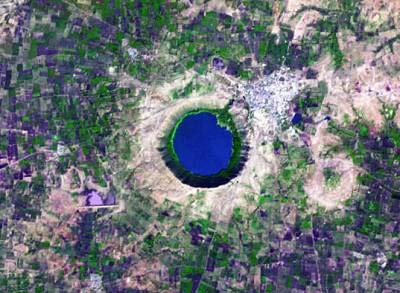
Lonar Crater
Remarkable large impact craters
-
Vredefort Crater in South Africa, the largest known impact crater on Earth (300 km in diameter)
-
Chicxulub crater near the Yucatan coast (170 km in diameter)
-
Lake Manicouagan in Québec, Canada (100 km in diameter)
-
Popigai Crater in Russia (100 km in diameter)
-
Acraman Crater in South Australia (90 km in diameter)
-
Chesapeake Bay impact crater (90 km in diameter)
-
Lake Siljan in Sweden, the largest crater in Europe (52 km in diameter)
-
Manson Crater, Iowa
-
Clearwater Lake, Canada.
-
Lonar Crater, India, (1.83 km in diameter).

Barringer Crater
Part 2
How do we recognize a meteorite?
This is quite difficult. The safest way to do that would be to drop it right on your head. But that's only been proven to have happened once.
There is no general and sufficiently reliable criterion that can be used to immediately determine the cosmic origin of a suspicious piece of rock. A suspected meteorite is therefore subjected to both mineralogical and chemical analysis. Also important is the examination of radioisotopes, which can often tell us how long the material of the original body has been exposed to cosmic rays.
For many meteorites, a distinguishing feature is the presence of rounded, circular pits that resemble fingerprints, called regmaglypts. They are formed by supersonic jets during passage through the atmosphere (the Caracol meteorite). As a general rule, the larger the meteorite, the larger these dimples are. On the other hand, it is also true that they do not always form.
Iron meteorites that have not been much affected by terrestrial weathering are characterised by a very thin black crust of melting. Its thickness rarely exceeds one or two millimetres (Sikhote-Alin meteorite). Although the crust is the main distinguishing feature, it can be very thin and will disappear soon after the fall under weathering. In addition, every now and then a meteorite will break into several pieces in flight, exposing the inner, unblackened parts.
You can use our metal detectors to search for iron meteorites.
After etching iron meteorites with dilute nitric acid, the typical Widmanstätten patterns appear on the polished surfaces. However, there are also iron meteorites without these patterns. Iron meteorites can also be recognised due to their high specific gravity. They are therefore noticeably heavier than ordinary terrestrial rocks.
In the case of rocky meteorites, the spherical formations - chondrules - which are not found in terrestrial rocks, are particularly visible on the flakes. In some cases they are the size of a pinhead, in others like a pea. Small grains of iron can often be seen scattered among the other parts.
There are, however, stone meteorites without chondrites, and also very rare carbonaceous chondrites. Although they are the most abundant in the universe, they are the most fragile space rocks and rarely survive passage through the atmosphere. And if they do, they disintegrate rapidly in the air. At first glance, they look like a lump of coal because of their high organic content, and if you get them wet, they usually smell bad. For experts, carbonaceous chondrites are the stuff of gold!
Stone chondrites are most abundant in interplanetary space. Iron meteorites dominate Earth's collections because they more easily survive the scorching flight through Earth's atmosphere and are conspicuous long after they fall.
Theweights and irregular sizes of meteorites vary from the finest dust particles to multi-ton pieces (accompanied by the formation of a crater that is unmissable). The largest known meteorite is called Hoba, located in Namibia, and weighs sixty tons. It fell at least a few thousand years ago (possibly millions). And it was originally about a hundred tons.
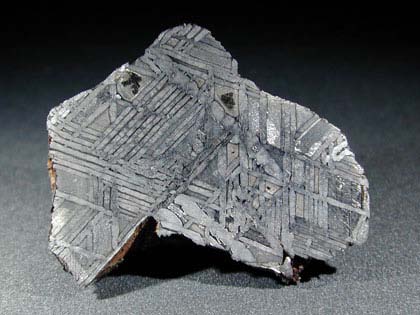
an iron meteorite
A meteorite as a jewel.
Meteorites, although not very good-looking, have made their way into the gemstone category. Although they do not have the supposed properties that would classify them as precious stones, the dictates of fashion are relentless. It has not yet appeared in this country, but in the Western markets we meet with jewels adorned with iron or stone meteorite.
You can find them at:
http://www.naturshop.cz/meteorit-sikhote-alin-rusko-p-4244.html
http://www.torrin.cz/meteority-a-tektity/meteority/meteorit-sikhote---alin-sibir.html
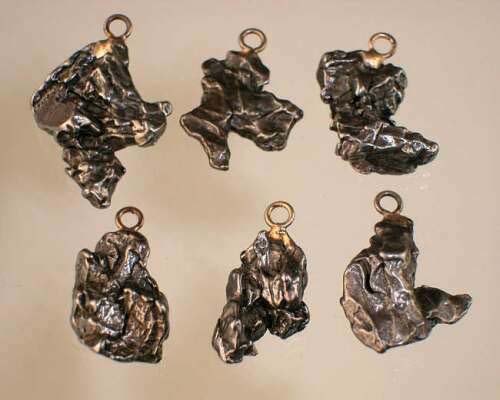
Pendants
Remarkable meteorites
-
Allende, the largest known meteorite (Chihuahua, Mexico, 1969)
-
Allan Hills 84001 - a meteorite that has been talked about as evidence of life on Marz
-
Canyon Diablo - an iron meteorite used by pre-historic Native Americans
-
Cape York - one of the largest meteorites in the world. It is on display at the Museum of American History
-
Ensisheim meteorite - the oldest meteorite whose fall is precisely dated ( November 7, 1492, Ensisheim)
-
Fukang meteorite - It was offered at auction for $3 million in April 2008
-
Hoba - the largest known meteorite
-
Kaidun - possibly from the Martian moon Phobos
-
Murchison - contains nucleobases - the building blocks of life
-
Willamette - the largest meteorite in the United States
-
Bacubirito meteor (Meteroito de Bacubirito) - weighs 20 to 30 tons
-
The black stone in the Kaaba wall in Mecca - scientists believe it is also a meteorite.
How much?
Our leading geologist Petr Jakeš from the Faculty of Science of Charles University in Prague (Institute of Mineralogy, Geochemistry and Mineral Resources), who has so far been the only Czech involved in NASA research on lunar rocks, told ČTK: "Siberian meteorites sell for around 10 CZK per gram in Prague.
According to him and Pavel Suchan of the Czech Astronomical Society, meteorites are traded in Prague and many collectors already own them.
Theworld's largest exchange where they can be traded is in Tuescon in Arizona (USA), and in Europe in Munich.
TheYamato Meteorite 793169, found on November 20, 1979, as part of a Japanese National Institute of Polar Research project on an ice field near the Yamato Mountains (Antarctica), came from the Moon. The Randy L. Korotev list of lunar meteorites lists only thirty finds of these rare messengers from the heavens. According to Sara R. M. Grady's meteorite catalog, which lists over 20,000 meteorites, lunar meteorites represent only a few hundredths of one percent of the total. The value of lunar meteorites is therefore enormous. While we would pay about five hundred crowns for a gram of platinum and about four hundred crowns for a gram of gold, we would pay over one hundred thousand crowns for a gram of lunar meteorite!
The Valley of the Sky meteorite, which scientists believe came from the asteroid belt between Mars and Jupiter, was discovered in Argentina's Compo del Cieli crater and sold for $93,000 at the New York Stock Exchange.
Where to?
Finders of a possible meteorite can take the stone to:
the National Museum in Prague, the Astronomical Institute of the Academy of Sciences of the Czech Republic in Ondřejov, the Faculty of Science of Charles University in Prague, and the University of Prague. In the geological collections of one of the larger museums (e.g. the Moravian Museum in Brno).
If you are lucky enough to record the meteorite fall or impact, the following data are extremely important for
experts: The exact time of the fall, the path in the atmosphere, a description of the accompanying phenomena (light, sound) and documentation (photographic) of the place where the stone or stones were found. Never touch the meteorite with your bare hand, wrap it carefully in a clean plastic bag and notify one of the above mentioned institutions or at least the nearest observatory.
The article is included in categories:
Post
Moc pěkný a zajímavý článek 
Pozoruhodné meteority
•Allende, největší známý meteorit (Chihuahua, Mexiko, 1969)
•Allan Hills 84001 – meteorit, o kterém se mluvilo jako o důkazu života na Marzu
•Canyon Diablo - meteorit železa používaný pre-historickými americkými domorodci
•Cape York - jeden z největších meteoritů na světě. Je vystaven v muzea americké historie
•Ensisheim meteorit - nejstarší meteorit jehož pád je přesně datován ( 7. listopadu 1492, Ensisheim)
•Fukang meteorit - Byl nabídnut v aukci za tři milióny USD v dubnu 2008
•Hoba - největší známý meteorit
•Kaidun - možná z Marzova měsíce Phobos
•Murchison - obsahuje nucleobases - stavební kámen života
•Willamette - největší meteorit ve Spojených státech
•Bacubirito meteor (Meteroito de Bacubirito) - váží 20 až 30 tun
•Černý kámen ve zdi Kaaba v Mekce - o něm se vědci domnívají, že je také meteoritem.
Zřejmě nechtěně opomenuta kráterní kotlina ČR. Vznik dopadem meteoritu, či atakem jiné planety, která tu musela zapomenout části oděvu, jen ty části najít.
Samozřejmě měl být přílepek k odstavci (Pozoruhodné velké impaktní krátery).
Jak to tak čtu, možná mám v kufru železnej meteorit  , dneska nafotím a pošlu.
, dneska nafotím a pošlu.
Do 6. 7. 2010 můžete v Národním muzeum v Praze vidět rezavě hnědý meteorit, který váží jednu tunu. Po chemické stránce je složen téměř z čistého železa. Jen 8% připadá na nikl a další příměsy. Jeho stáří se odhaduje na 800 - 900tis. let. Řadí se tak k nejstarším meteoritům. Byl nalezen ve Švédsku panem J. Šimkem, a to za použití detektoru, v hloubce cca dva metry. Nálezce jej muzeu věnoval.
mám spousty nálezů u kterých nemohu přijít na původ. U něčeho tuším, u něčeho ani vzdáleně. Nechcete udělat nějakou galerii takových "úlovků"? Ono hádat CoJeTo nebo spíš CoToBylo více lidmi, by nebylo marné...
to sů krátery jůůůůůůůůůů 
Také jeden kousek zřejmě vlastním,je z oblasti Deštného v O.horách.Našel jsem ho při jedné z pochůzek po okolí. 
Kdyby se někdo chtěl zbavit meteoritu výměnou za militárie nebo ho prodává pište na buchadlo@gmail.com 
zdravým. vedel by mi niekto poradiť ? našiel som dosť dávno neaký kameň skor to vyzerá ako železná hornina ale na taký malí kúsok dosť váži a je mierne magnetický. kde sa dá zistiť čo to je v skutočnosti či to neje náhodou meteorit. pozeral som neaké fotky meteoritov a dosť sa podobá na jeden . preto ma to začalo zaujímať .
Zaujimam sa o meteority - aj s v nich trosku vyznam, poradit mozem - a rad 
Všechny Vaše kameny o kterých si myslíte že by to mohly být kameny z Vesmíru si rád prohlédnu.Vesmírný kámen poznáte!!!Jsou tři základní druhy.Kamenný,železokamenný a železný,Kamenný meteorit Chondrit má většinou natavenou zčernalou kůru a to nejdůležitější má chondrule,což jsou malý kuličky křemičitanu které se na Zemi nevyskytují,myslím ty kuličky ,každý nerost má svoji krystalickou strukturu a v tom to je,žádný nerost nemá kulatou krystalickou strukuru,navíc chondrule jsou různě veliký od viditelnosti pod mikroskopem až do velikosti řádů milimetrů,navíc pod ůplně jednoduchým mikroskopem jsou na jednotlivých chondrulích vidět čárová krystalizace která vzniká po dodobu milionu let chladnutí.mezi chondrulamy se nacházejí drobounké šrapnely kovu.O železných a kamennoželezných napíši příště jestli bude zájem.©mitom07 
To je kráter jako cecky mojí ženy! :O
udelat rozbor v Praze a bude to struska, 
Allende, největší známý meteorit (Chihuahua, Mexiko, 1969)............chybná informace.Jde o uhlíkatý meteorit o odhadované celkové váze 5t.Meteorit Hoba měl v době nálezu 66t.Dnes 60t.


















